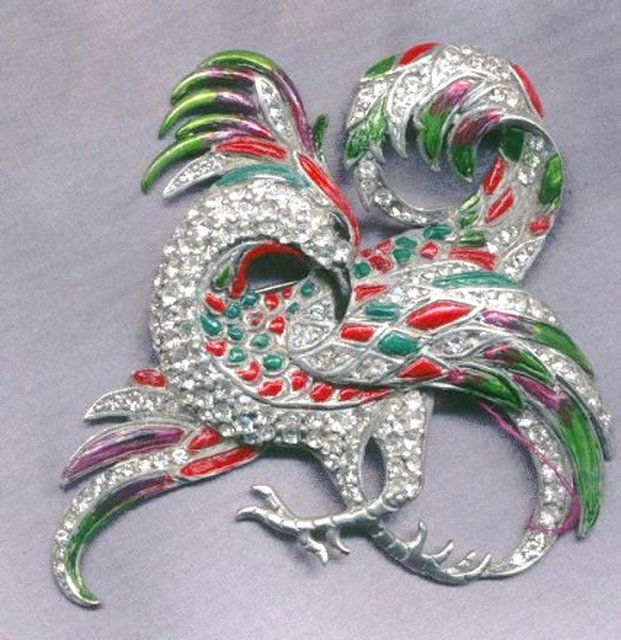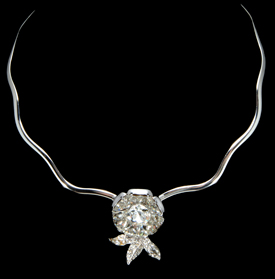
Early Canadian Sterling & Enamel Souvenir Jewelry
August 1, 2014
Katerina Musetti Presents a CJCI 2014 Exclusive
October 2, 2014by Kathryn Drury Wagner – Exclusively for CJCI
Whether you’ve amassed it for fun or profit, your collection has real value. Here’s how to protect against loss.
In many instances costume jewelry is less expensive than fine jewelry, but for those of us who collect, these are hard-won treasures amassed over decades. They might even be family heirlooms or the bread-and-butter of a business. And while individual pieces are generally affordable—that’s one of the pleasures of costume jewelry—the value of a collection can easily add up. Twenty dollars here, $130 there, $30 over here … whoa, you may find you have $5,000 worth of scintillating goodies in your jewelry armoire before you know it!
In the event of a fire, flood or theft, you’d be devastated to lose your sparkling collection, but having a solid plan can help you avoid problems and ensure that you’ll at least get reimbursed if you need to start over from scratch. Consider these ideas to help you protect your collection.
DOCUMENT YOUR STASH
Keep an inventory of your costume jewelry, with information on each item, when you bought it, the amount you paid for it, and if you’ve had it appraised, list the value. Photograph or take video images of your collection. Be sure to email yourself a copy of the images and the inventory list, and copy your insurance agent, so you’ll have proof of ownership, should you need it. Print out the list periodically and store it in your safe or safe deposit box with other important papers, if you have one. (If you keep your inventory solely on your computer, the list is no good to you if your computer is stolen or damaged.) You should also save receipts and any written appraisals pertaining to your collection and store them in a secure place.
You can also consider hiring a certified appraiser to value your collection. Doing so every two to five years is recommended, especially if you buy additional insurance to cover a collection. The Appraisers Association of America has a handy directory on its website in case you need a point of departure in finding an appraiser.
Also, don’t forget to make a note in your inventory when you sell, trade or give away a piece so you’ll always have an accurate record of your stockpile.
INSURING A COLLECTION
“Doesn’t my homeowner’s insurance cover my collection?” you ask. Probably not. Basic homeowner’s and renters insurance lump valuables into categories, and set a cap on them. For example, there may be a $1,000 limit per piece of jewelry, and a $2,500 limit for all jewelry as a group. If your valuables exceed your policy’s limits, look into the option of buying additional coverage.
Scheduled Personal Property coverage, also called a “floater policy,” is a separate rider that can boost your homeowner’s insurance, and generally has fewer limitations and a lower deductible than standard personal property coverage. You may or may not be asked to use an appraiser to value your collection when you apply for this type of coverage. You can talk to your insurance agent to add to your existing policy, but also consider shopping around with other companies for better deals and coverage à la carte as well.
The cost for a jewelry rider will vary depending on which insurance company and policy you have, but the cost isn’t too extravagant for a low- to moderately-valued collection. One company asked for a quote offered $5,000 in coverage for $84 a year, another quoted $5,000 in coverage for $75, but also had a $100 deductible to pay in the event of loss.
Now, if you’re running a home-based business selling costume jewelry, you’ll need additional insurance, because standard homeowner’s insurance policies won’t cover your business property. Think about getting:
Commercial property insurance – You’ll want to insure your inventory of jewelry against loss or damage, but also any tools, shipping supplies, computer and printer, and display cases that are part of your business.
General liability insurance – To cover damage claims that might arise during a trade show, trunk show or in your home if it doubles as a workspace. It sounds silly, but people get sued for all sorts of things, and the last thing you need is someone claiming damage from choking on a rhinestone or slipping on a faux pearl.
Business owners policies – These allow you to bundle policies, such as general liability insurance and property insurance, as well as business interruption coverage. Talk to your insurance agent about the right choice for your small business.
OTHER OPTIONS FOR SAFEGUARDING COSTUME JEWELRY
Safe deposit boxes are a good alternative, particularly if you own important pieces and rarely wear them. They also provide dealers a storage solution for high-end back stock, too.
Private vaults are accessible 24 hours a day, seven days a week, unlike a bank, and have a better range of box sizes available. But renting a private vault can get pricey; around $400 a year. Investing in the one-time cost of a floor or wall safe and its installation can often be more cost effective in the long run.
One dealer says she spent about $2,500 to get a large, top-notch floor safe delivered and installed in her home to protect her costly inventory against theft. Safes of this nature are also fireproof for 60-90 minutes depending on the model, and many have a “Cool Pocket” inside the door to further protect important personal and business-related documents.
Insurers may also give discounts for the use of a safe or for having a home security system installed, so talk with your agent about whether or not you qualify.
GENERAL SAFETY TIPS
Lastly, a few tips on general safety for your costume jewelry collection:
• Practice good preservation techniques to avoid damage. Keep jewelry out of direct sunlight, away from extreme temperature changes, and in sealed containers so dust can’t accumulate.
• Security experts actually warn against jewelry boxes and armoires, which are easy for a thief to grab. Store the bulk of your jewelry collection in a less obvious place or consider using a smaller safe that is too heavy to easily snatch.
• If you are traveling with your favorite costume jewelry, don’t check it in your luggage; take it in your carry-on instead. Use a hotel-provided room safe when available, just as you would with fine jewelry.
• Don’t leave your collection unattended in an automobile. Store the bag containing your jewelry in the trunk, rather than visible on a seat when traveling by car. In matter of seconds, a thief can shatter a car window, grab your bag, and be gone before you even know what happened.
Do what you can to feel safe — whether that is adding to your insurance policy, renting a safe deposit box or having a safe installed in your home, and then wear and enjoy your beautiful collection. What’s the point of having lovely things, after all, if you can’t show them off?
Kathryn Drury Wagner is a freelance writer and editor based in Los Angeles. She blogs about vintage styles at The Girl, The Gold Watch & Everything.




